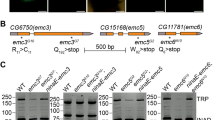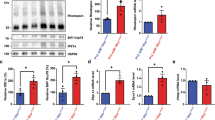Abstract
Chronic stress in the endoplasmic reticulum (ER) underlies many degenerative and metabolic diseases involving apoptosis of vital cells. A well-established example is autosomal dominant retinitis pigmentosa (ADRP), an age-related retinal degenerative disease caused by mutant rhodopsins1,2. Similar mutant alleles of Drosophila Rhodopsin-1 also impose stress on the ER and cause age-related retinal degeneration in that organism3. Well-characterized signalling responses to ER stress, referred to as the unfolded protein response4 (UPR), induce various ER quality control genes that can suppress such retinal degeneration5. However, how cells activate cell death programs after chronic ER stress remains poorly understood. Here, we report the identification of a signalling pathway mediated by cdk5 and mekk1 required for ER-stress-induced apoptosis. Inactivation of these genes specifically suppressed apoptosis, without affecting other protective branches of the UPR. CDK5 phosphorylates MEKK1, and together, they activate the JNK pathway for apoptosis. Moreover, disruption of this pathway can delay the course of age-related retinal degeneration in a Drosophila model of ADRP. These findings establish a previously unrecognized branch of ER-stress response signalling involved in degenerative diseases.
This is a preview of subscription content, access via your institution
Access options
Subscribe to this journal
Receive 12 print issues and online access
$209.00 per year
only $17.42 per issue
Buy this article
- Purchase on Springer Link
- Instant access to full article PDF
Prices may be subject to local taxes which are calculated during checkout





Similar content being viewed by others
References
Dryja, T. et al. A point mutation of the rhodopsin gene in one form of retinitis pigmentosa. Nature 343, 364–366 (1990).
Sung, C. H. et al. Rhdopsin mutations in autosomal dominant retinitis pigmentosa. Proc. Natl Acad. Sci. USA 88, 6481–6485 (1991).
Ryoo, H. D., Domingos, P. M., Kang, M. J. & Steller, H. Unfolded protein response in a Drosophila model for retinal degeneration. EMBO J. 26, 242–252 (2007).
Walter, P. & Ron, D. The unfolded protein response: from stress pathway to hemeostatic regulation. Science 334, 1081–1086 (2011).
Kang, M-J. & Ryoo, H.D. Suppression of retinal degeneration in Drosophila by stimulation of ER-associated degradation. Proc. Natl Acad. Sci. USA 106, 17043–17048 (2009).
Travers, K. J. et al. Functional and genomic analyses reveal an essential coordination between the unfolded protein response and ER-associated degradation. Cell 101, 249–258 (2000).
Harding, H. P. et al. An integrated stress response regulates amino acid metabolism and resistance to oxidative stress. Mol. Cell 11, 619–633 (2003).
Yamamoto, K. et al. Transcriptional induction of mammalian ER quality control proteins is mediated by single, or combined action of ATF6α and xbp1. Dev. Cell 13, 365–376 (2007).
Colley, N. J., Cassill, J. A., Baker, E. K. & Zuker, C. S. Defective intracellular transport is the molecular basis of rhodopsin-dependent dominant retinal degeneration. Proc. Natl Acad. Sci. USA 92, 3070–3074 (1995).
Kurada, P. & O’Tousa, J. E. Retinal degeneration caused by dominant rhodopsin mutations in Drosophila. Neuron 14, 571–579 (1995).
Hewes, R. S., Schaefer, A. M. & Taghert, P. H. The cryptocephal gene (ATF4) encodes multiple basic-leucine zipper proteins controlling molting and metamorphosis in Drosophila. Genetics 155, 1711–1723 (2000).
Harding, H. P. et al. Regulated translation initiation controls stress-induced gene expression in mammalian cells. Mol. Cell 6, 1099–1108 (2000).
Marciniak, S. J. et al. CHOP induces death by promoting protein synthesis and oxidation in the stressed endoplasmic reticulum. Genes Dev. 18, 3066–3077 (2004).
Li, G., Scull, C., Ozcan, L. & Tabas, I. NADPH oxidase links endoplasmic reticulum stress, oxidative stress and PKR activation to induce apoptosis. J. Cell Biol. 191, 1113–1125 (2010).
Song, B. et al. Chop deletion reduces oxidative stress, improves β cell function, and promotes cell survival in multiple mouse models of diabetes. J. Clin. Invest. 118, 3378–3389 (2008).
Timmins, J. M. et al. Calcium/calmodulin-dependent protein kinase II links ER stress with Fas and mitochondrial apoptosis pathways. J. Clin. Invest. 119, 2925–2941 (2009).
Tu, B. P. & Weissman, J. S. Oxidative protein folding in eukaryotes: mechanisms and consequences. J. Cell Biol. 164, 341–346 (2004).
Morrison, D. K., Murakami, M. S. & Cleghon, V. Protein kinases and phosphatases in the Drosophila genome. J. Cell Biol. 150, 57–62 (2000).
Connell-Crowley, L., Le Gall, M. & Giniger, E. The cyclin-dependent kinase CDK5 controls multiple aspects of axon patterning in vivo. Curr. Biol. 10, 599–602 (2000).
Tsai, L. H., Delalle, I., Caviness, V. S., Chae, T. & Harlow, E. p35 is a neural-specific regulatory subunit of cyclin-dependent kinase 5. Nature 371, 419–423 (1994).
Choi, J. H. et al. Anti-diabetic drugs inhibit obesity-linked phosphorylation of PPARγ by CDK5. Nature 466, 451–456 (2010).
Wei, F. Y. et al. CDK5-dependent regulation of glucose-stimulated insulin secretion. Nat. Med. 11, 1104–1108 (2005).
Saito, T. et al. p25/cyclin-dependent kinase 5 promotes the progression of cell death in nucleus of endoplasmic reticulum-stressed neurons. J. Neurochem. 102, 133–140 (2007).
Patrick, G. N. et al. Conversion of p35 to p25 deregulates CDK5 activity and promotes neurodegeneration. Nature 402, 615–622 (1999).
Qu, D. et al. Role of CDK5-mediated phosphorylation of Prx2 in MPTP toxicity and Parkinson’s disease. Neuron 55, 37–52 (2007).
Elbein, A. D. Inhibitors of glycoprotein synthesis. Methods Enzymol. 98, 135–154 (1983).
Connell-Crowley, L., Vo, D., Luke, L. & Giniger, E. Drosophila lacking the CDK5 activator, p35, display defective axon guidance, age-dependent behavioral deficits and reduced lifespan. Mech. Dev. 124, 341–349 (2007).
Rorth, P. A modular misexpression screen in Drosophila detecting tissue-specific phenotypes. Proc. Natl Acad. Sci. USA 93, 12418–12422 (1996).
Hay, B. A., Wasserman, D. A. & Rubin, G. M. Drosophila homologs of baculovirus inhibitor of apoptosis proteins function to block cell death. Cell 83, 1253–1262 (1995).
Inoue, H. et al. A Drosophila MAPKKK, D-MEKK1, mediates stress response through activation of p38 MAPK. EMBO J. 20, 5421–5430 (2001).
Seong, K. H., Li, D., Shimizu, H., Nakamura, R. & Ishii, S. Inheritance of stress-induced, ATF-2-dependent epigenetic change. Cell 145, 1049–1061 (2011).
Lytton, J., Westlin, M. & Hanley, M. R. Thapsigargin inhibits the sarcoplasmic or endoplasmic reticulum Ca-ATPase family of calcium pumps. J. Biol. Chem. 266, 17067–17071 (1991).
Chew, S. K. et al. The apical caspase dronc governs programmed and unprogrammed cell death in Drosophila. Dev. Cell 7, 897–907 (2004).
Xu, D., Li, Y., Arcaro, M., Lackey, M. & Bergmann, A. The CARD-carrying caspase Dronc is essential for most, but not all, developmental cell death in Drosophila. Development 132, 2125–2134 (2005).
Pichaud, F. & Desplan, C. A new visualization approach for identifying mutations that affect differentiation and organization of the Drosophila ommatidia. Development 128, 815–826 (2001).
Lee, M. S. et al. Neurotoxicity induces cleavage of p35 to p25 by calpain. Nature 405, 360–364 (2000).
Dhavan, R., Greer, P. L., Morabit, M. A., Orlando, L. R. & Tsai, L. H. et al. J. Neurosci. 22, 7879–7891 (2002).
Nakagawa, T. & Yuan, J. Cross-talk between two cysteine protease families. Activation of caspase-12 by calpain in apoptosis. J. Cell Biol. 150, 887–894 (2000).
Zhang, Y. et al. Epigenetic blocking of an enhancer region controls irradiation-induced proapoptotic gene expression in Drosophila embryos. Dev. Cell 14, 481–493 (2008).
Brand, A. H. & Perrimon, N. Targeted gene expression as a means of altering cell fates and generating dominant phenotypes. Development 118, 401–415 (1993).
Xu, T. & Rubin, G. M. Analysis of genetic mosaics in developing and adult Drosophila tissues. Development 117, 1223–1237 (1993).
Riesgo-Escovar, J. R., Jenni, M., Fritz, A. & Hafen, E. The Drosophila Jun-N-terminal kinase is required for cell morphogenesis but not for DJun-dependent cell fate specification in the eye. Genes Dev. 10, 2759–2768 (1996).
Glise, B. & Noselli, S. Coupling of Jun amino-terminal kinase and Decapentaplegic signaling pathways in Drosophila morphogenesis. Genes Dev. 11, 1738–1747 (1997).
Armknecht, S. et al. High-throughput RNA interference screens in Drosophila tissue culture cells. Methods Enzymol. 392, 55–73 (2005).
Tomlinson, A. The cellular dynamics of pattern formation in the eye of Drosophila. J. Embryol. Exp. Morphol. 89 (1985).
Acknowledgements
We thank E. Giniger (NIH, USA), K. Matsumoto (Nagoya University, Japan), M. Miura (Tokyo University, Japan), the VDRC and Bloomington stock centres for reagents, E. Robbins, M. Pagano and E. Zito for technical advice, and D. Ron for discussions and critical comments on the manuscript. This work was supported by the National Institutes of Health grant R01EY020866. H.D.R. is an Ellison Medical Foundation New Scholar.
Author information
Authors and Affiliations
Contributions
M-J.K. and H.D.R. designed the experiments. J.C. carried out the EPgy2 screen. All other experiments were carried out by M-J.K. H.D.R. wrote the paper and all authors read and edited the manuscript.
Corresponding author
Ethics declarations
Competing interests
The authors declare no competing financial interests.
Supplementary information
Supplementary Information
Supplementary Information (PDF 969 kb)
Supplementary Table 1
Supplementary Information (XLS 195 kb)
Rights and permissions
About this article
Cite this article
Kang, MJ., Chung, J. & Ryoo, H. CDK5 and MEKK1 mediate pro-apoptotic signalling following endoplasmic reticulum stress in an autosomal dominant retinitis pigmentosa model. Nat Cell Biol 14, 409–415 (2012). https://doi.org/10.1038/ncb2447
Received:
Accepted:
Published:
Issue Date:
DOI: https://doi.org/10.1038/ncb2447
This article is cited by
-
CDK5 promotes apoptosis and attenuates chemoresistance in gastric cancer via E2F1 signaling
Cancer Cell International (2023)
-
Nacα protects the larval fat body from cell death by maintaining cellular proteostasis in Drosophila
Nature Communications (2023)
-
Wg/Wnt1 and Erasp link ER stress to proapoptotic signaling in an autosomal dominant retinitis pigmentosa model
Experimental & Molecular Medicine (2023)
-
Endoplasmic reticulum stress: molecular mechanism and therapeutic targets
Signal Transduction and Targeted Therapy (2023)
-
Cinnamaldehyde induces autophagy-mediated cell death through ER stress and epigenetic modification in gastric cancer cells
Acta Pharmacologica Sinica (2022)



